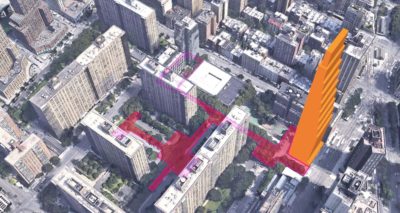
200 Amsterdam Avenue Rendering Image Credit: SJP Properties
Advocates applaud decision while developers find decision deeply flawed. On February 15, 2020, the Committee for Environmentally Sound Development and the Municipal Art Society of New York, won an Article 78 case regarding the construction of a 668 foot, 52-story condominium building located at 200 Amsterdam Avenue on the Upper West Side of Manhattan. New York County Supreme Court Justice W. Franc Perry’s ruling requires the Department of Buildings to revoke the building permit and compel the developers, SJP Properties and Mitsui Fudosan America, to remove the floors that exceed what is permitted under the Zoning Resolution.
The developers, in order to build higher and larger, sought a transfer of development rights through a Zoning Lot Merger. The transfer still permits the development to be built “as-of-right.” A Zoning Lot Merger is not technically a transfer of development rights, but a shifting of development rights within a unified zoning lot. In many cases, zoning lots can be contiguous to the tax lots. In this case the developer entered into agreements to transfer the development rights from two tax lots and portions of four other tax lots, resulting in a 39-sided zoning lot. On September 27, 2017, the Department of Buildings issued the developer a building permit to construct the high-rise condominium building with the additional development rights.
The Committee for Environmentally Sound Development and the Municipal Art Society (“MAS”) took issue with the way the developer amassed the additional development rights, believing the zoning lot was “gerrymandered,” and in violation of the Zoning Resolution’s definition of “zoning lot” and thereafter challenged the issuance of the permit at the Board of Standards and Appeals. On July 17, 2018, BSA issued a resolution upholding the building permit on the grounds that partial tax lots used to transfer development rights could be considered a “zoning lot” under the City’s Zoning Resolution. In the midst of the BSA appeal, the Department of Buildings issued a draft bulletin intending to dispel an earlier Department of Buildings memorandum interpreting the definition of “zoning lot.” The more recent interpretation did not allow partial tax lots to be included in a “zoning lot.” BSA did not view the first memo as being rescinded/superseded by the draft bulletin, and BSA did not agree with the draft bulletin’s statutory interpretation of “zoning lot.”
The Committee for Environmentally Sound Development and MAS filed an initial Article 78 petition and won on the grounds that BSA’s interpretation was erroneous from the plain text reading of the statute. The court credited the Department of Building’s second interpretation, disallowing partial tax lots to be included in the definition of a “zoning lot.” The case was remanded to BSA in March of 2019 because the court chose not to interpose itself in the interpretation of the Zoning Resolution and because DOB already resolved the statutory interpretation issue in their draft bulletin. The court order advised BSA to review the approval “in accordance with the plain language of the [Zoning Resolution]” and with the material contained in the decision.

200 Amsterdam Zoning Lot and Building Rendering Image Credit: Municipal Art Society of New York
In June 2019, BSA issued a second resolution upholding the legality of the building permit and their original interpretation of “zoning lot.” BSA reasoned that the plain language of the statute led to the same conclusion and the first Department of Buildings’ interpretation was still not superseded by the draft bulletin’s second interpretation. The Committee for the Environmentally Sound Development and MAS brought this second Article 78 action, re-challenging BSA’s “amended resolution.”
In proving the second Article 78, the Committee for Environmentally Sound Development and MAS were required to prove that the BSA acted arbitrarily and capriciously in re-approving the building permit. In stout language Justice Perry wrote “DOB properly exercised its authority by identifying an erroneous interpretation of the Zoning Resolution and by publishing a proposed amendment to the error. BSA, however, balked in its Duty,” adding “BSA sidestepped this issue twice… As such, this issue remains unsolved, and as it presents a question of pure legal interpretation, this court is empowered to make this determination.” Justice Perry again found BSA’s interpretation incorrect based on the plain text reading of the statute, and was again persuaded by Department of Building’s draft bulletin interpretation of “zoning lot.” According to the court, the statutory interpretation of “zoning lot” cannot consist of partial tax lots because it would render the word “unsubdivided,” superfluous. Therefore, the partial tax lots could not be included as part of the zoning lot and eligible to transfer the development rights to 200 Amsterdam Ave. Justice Perry also noted that BSA “wholly ignored” the prior Article 78 decision, thus BSA’s revised resolution was not entitled to substantial deference.
The court not only nullified BSA’s resolution, but Justice Perry also ordered the Department of Buildings to revoke the building permit and compel the Owner to remove all floors exceeding what is permitted under the zoning resolution. The fact that construction was almost complete gained little sympathy from the judge. According to the judge, the building’s construction had not “proceeded past installation of the building footings” at the time the first appeal was filed. Additionally, the decision states the owner acknowledged the challenges to the permit’s validity in a court stipulation, yet completed “much of the construction work” by the time the first decision was entered. The court stipulation prohibited the developers from claiming expenses between May 2018 and March 19, 2019.
Comment
CityLand reached out to Paul D. Selver of Kramer Levin and Scott E. Mollen of Herrick Feinstein LLP, attorneys for the developers. Mollen explained that the decision was flawed in numerous ways. He stated that “the decision placed undue weight on a draft bulletin that had never been adopted as official Department of Buildings policy. The prior Minkin Memo, has been followed for more than four decades and has never been amended or rescinded.” Mollen added that numerous buildings throughout the City have Certificates of Occupancy based on developments that include partial tax lots. He also pointed out that the draft bulletin has still never been adopted.
Responding to the stipulation, Mollen explained that an “enormous amount of work and investment occurred after the stipulation expired. All done in reliance on the existing law.” Mollen pointed out that with big projects, opponents will often lodge or submit objections but a developer has a right to rely on an agency advising that their permit is valid, especially with no injunction in place.
Paul Selver also emphasized the long-standing history of including partial-tax lots in zoning lots. He stated over the past 40 years “there were approximately 34 instances of permits or certificates of occupancy issued to buildings that included partial tax lots. This [development] is not one-off. This is a written interpretation and pattern of practice.” Selver claimed this technicality has never been challenged before. He then added “we felt a court would look at this as a classic agency interpretation of the statute given the statute is not crystal clear…The former interpretation was a reasonable interpretation and the reliance on that interpretation was reasonable, therefore, just like all the others that relied on that interpretation, this building should be able to proceed.”
The developers also appear to take the stance that if the court is promulgating a new rule, rather than making an interpretation, their rights would have vested and prohibit retroactive application. Selver then explained if the decision stands, it would mean “all those buildings [built with partial tax lots], that our client relied on, are now illegal.” He claims, if the City finds a way to legalize those buildings, his clients are entitled to the same fix. Adding, “Our reliance on Buildings department interpretation was just as great as those other buildings, we just happened to get started later.”
In a press release, Elizabeth Goldstein, President of the Municipal Art Society stated, “We are very gratified that after a long fight, the gerrymandered zoning lot at 200 Amsterdam has been declared illegal. This groundbreaking decision averts a dangerous precedent that would have ultimately affected every corner of the city,” she added “The directive to partially demolish the building is appropriate given the willingness of the developer to ignore every sign that their project was inappropriately scaled for the neighborhood and based on a radically and wildly inaccurate interpretation of the Zoning Resolution.” MAS is now vying for DOB to issue a Stop Work Order at the development.
CityLand reached out to the Committee for Environmentally Sound Development and MAS’s attorney Richard Emery of Emery Celli Brinckerhoff & Abady LLP, who stated “developers and those who finance development need to get the community on their side and that is what this case stands for…building with respect for the community.”
Council Member Ben Kallos said that “developers should be on notice… If you want to get one over on the public, there are committed elected officials and organizations like The Committee for Environmentally Sound Development and the Municipal Art Society who will hold developers accountable,” he added, “if you want to build housing, build it affordable or if you’re going to build market rate housing, make it affordable for all New Yorkers.”
CityLand reached out to the City for comment and Nick Paolucci, Law Department spokesman, advised that the City is “evaluating its legal options.”
By: Jason Rogovich (Jason Rogovich is the CityLaw Fellow and New York Law School Graduate, Class of 2019)


This happened a while back. A developer built the frames for three tall apartment structures out in Rockaway. The City stopped it. They went to court and he had to take them down. They were there for years though.